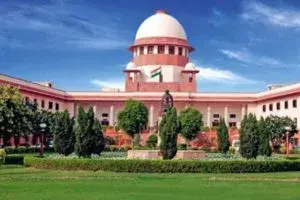In Withdrawal of CIRP before Constitution of CoC
Rights of Daughter when Father dies Intestate- Supreme Court
Rummy Circle Gambling
Withdrawal of CIRP before Constitution of CoC

By Nihit Nagpal and Anuj Jhawar
The Insolvency and Bankruptcy Code, 2016 empowers Financial Creditor, Operational Creditors, and Corporate Debtor to initiate the Corporate Insolvency Resolution Process (CIRP) upon a default being committed by a Corporate Debtor1. CIRP involves the setting up of a Committee of Creditors (CoC) and approval of a resolution plan to restructure the Corporate Debtor, or the liquidation of the Corporate Debtor. Often, Creditors and Corporate Debtor prefer to reach amicable settlements instead of going through with the entire CIRP process. This can achieve a better outcome for the creditor than the resolution plan would. Settlements also ensure that the creditor gets paid in a timely manner, before the Corporate Debtor’s assets deteriorate to a great extent, and they also protect Corporate Debtor from the risk of liquidation.
Section 12A of the Insolvency and Bankruptcy Code, 2016 allows the applicant for CIRP to approach the Adjudicating Authority for withdrawing the application, subject to obtaining approval from 90% voting share of the CoC2. The provision must be read with Regulation 30A of the Insolvency and Bankruptcy Board of India (Insolvency Process for Corporate Persons) Regulations, 2016, which prescribe separate processes for withdrawal of CIRP before and after the CoC has been constituted3. Approval of the CoC is not necessary to apply to the Adjudicating Authority under Section 12A of the Code if the CoC has not been constituted4. The position of law on this point was further clarified by the Hon’ble National Company Law Appellate Tribunal (NCLAT) in its recent judgement dated January 07, 2022 in M/S Ashish Ispat Pvt. Ltd. v Primuss Pipes and Tubes Ltd5.
M/S Ashish Ispat Pvt. Ltd. v Primuss Pipes and Tubes Ltd- Brief facts
The Appellant, M/S Ashish Ispat Pvt Ltd., was an Operational Creditor of the Respondent Corporate Debtor, Primuss Pipes and Tubes Ltd. The Appellant filed an application for initiating CIRP against the Respondent under Section 9 of the Insolvency and Bankruptcy Code, 2016. The Appellant and Respondent reached an amicable settlement and the Appellant, through the Interim Resolution Professional (IRP) filed an application under Section 12A to withdraw the Section 9 application. The Section 12A application was filed by the IRP with the NCLT, and the CoC was constituted 2 days later. The CoC consisted of two Financial Creditor, and one of them did not consent to the withdrawal of CIRP. The dissenting creditor had 17% voting shares, therefore, the NCLT rejected the application for withdrawal of CIRP. The Operational Creditor then filed an appeal before the NCLAT.
NCLAT’S Judgment- CoC’s approval not required for filing a withdrawal of CIRP
The NCLAT allowed the appeal, setting aside the order of the NCLT. The NCLAT first discussed the language of Regulation 30A, which provides for separate procedures for filing withdrawal applications, before and after the constitution of the CoC. According to Regulation 30A(3), if an application is filed pre-constitution, it is submitted to the Adjudicating Authority by the IRP. As per Regulation 30A(4), if an application is filed post-constitution, it must first be considered by the CoC. The NCLAT also referred to Swiss Ribbons v Union of India, where the Hon’ble Supreme Court held that before the CoC is constituted, parties can directly approach the NCLT with their withdrawal applications6. The Appellate Tribunal also relied on other judgements of the Hon’ble Supreme Court and the NCLAT where pre-constitution withdrawal applications had been allowed without the consent of the CoC7. Keeping in mind the facts of the case, precedent, and the statutory scheme of Regulation 30A, the NCLAT decided that the approval of the CoC was not required for filing a withdrawal application in this case.
Conclusion
The question of seeking CoC’s approval for filing a withdrawal application under Section 12A of the Insolvency and Bankruptcy Code, 2016 arises only if the CoC is in existence on the date the application is filed. This is clear from the language of Regulation 30A of the IBBI regulations, 2016, and has been the unequivocal stand of the Hon’ble Supreme Court and the NCLAT in a series of preceding decisions.
[1] The Insolvency and Bankruptcy Code, 2016, No. 31 of 2016, §§7, 9, & 10.
[2] The Insolvency and Bankruptcy Code, 2016, No. 31 of 2016, §12A.
[3] Insolvency and Bankruptcy Board of India, Insolvency and Bankruptcy Board of India (Insolvency Resolution Process for Corporate Persons) Regulations, 2016, IBBI/2016-17/GN/REG004 (Notified on November 30, 2016), Regulation 30A.
[4] Insolvency and Bankruptcy Board of India, Insolvency and Bankruptcy Board of India (Insolvency Resolution Process for Corporate Persons) Regulations, 2016, IBBI/2016-17/GN/REG004 (Notified on November 30, 2016), Regulation 30A.
[5] Comp. App. (AT) (Ins.) No. 892 of 2021.
[6] (2019) 4 SCC 17
[7] Kamal K Singh v Dinesh Gupta, Civil Appeal No. 4933 of 2021; Sunil Tandon v Manoj Kumar Anand, Comp. App. (AT) (INS) Np. 283 of 2019; Anuj Tejpal v Rakesh Yadav, Comp. App. (AT) (INS) No. 283 of 2019.
Related Posts
When Father Dies Intestate Rights of Daughter – Supreme Court

By Lucy Rana and Devika Mehra
The Hon’ble Supreme Court in a recent judgment1 dated January 20, 2022 laid considerable emphasis on the importance of customary hindu succession law while pronouncing that daughters have the complete right to inherit their father’s self-acquired property even if the father dies intestate. The Apex Court also observed that Hindu Succession Act, 1956 has specific provisions that ensure that where a woman dies intestate and issueless, her property must devolve back to the source i.e. to her husband’s family or to her parents, as the case may be.
History of Succession in India
The Hindu Succession Act, 1956 was enacted, in the post-independence India, to bring a halt to the succession related disputes that occurred in the lives of Hindus in the India that became after Independence from British rule in 1947. The Act made it clear that all properties of a Hindu male, be it ancestral / coparcenary property, or the self-acquired property, shall devolve upon the made heirs of the Hindu male, with an exception to the widow of the deceased who would have only limited estate in the property of the deceased with a right to claim partition. The line of thought behind this law was the customary practice that a daughter marries into a new family, leaving behind her family of birth and thereby placing her new family as per priority. Therefore, keeping this in view, the property must devolve upon the son so that the ownership over a family property remains within the family via the son and the ownership does not dilute via the daughter.
Hindu Succession (Amendment) Act, 2005
With time the independence of women from the male members of their families including father, grandfather, husband, brother, son, et al became a prominent subject. With the changing and evolving mindset came the necessity to bring about necessary changes in the laws in force. This laid the foundation and enactment of the Hindu Succession (Amendment) Act, 2005 wherein it was established that the daughters, since their birth, have equal rights and liabilities as that of sons2 in the joint family property i.e. a daughter had become a coparcener vis-à-vis the ancestral property.
Certain questions continued to remain unanswered regarding whether this amendment had a retrospective effect which were eventually addressed to by the Hon’ble Supreme Court of India via various judgments. One such judgment3 4 stated that Section 6 of the Act would be applicable only when the coparcener and his daughter, both were alive on the date of commencement of the 2005 Amendment. In another judgment5, the Hon’ble Supreme Court, while agreeing with the principles laid down in the Phulavati judgment (supra), held that the 2005 amendment confers upon the daughter of the coparcener in her own right in the same manner as the son and accordingly, the female coparcener was given a share upon partition even if the father had died before the 2005 amendment came in force.
Rights of daughter unobstructed
Putting a full stop to all these questions, the Hon’ble Supreme Court in Vineeta Sharma vs Rakesh Sharma & Ors.6 held unobstructed heritage takes place by birth while obstructed heritage takes place after the death of the owner. Under Section 6 of the Act, the rights are given by birth which means that it is unobstructed heritage, independent of the owner’s death. A coparcener’s that the finding in Phulavati that the rights under Section 6 accrue to living daughters of living coparceners as on September 09, 2005 irrespective of when the daughter was born is misconceived. Phulavati judgment overlooked the concept of creation of coparcenary at birth and hence, the judgment was overruled. Accordingly, the decisions based on Phulavati judgment were also overruled while the Danamma judgment was partly overruled.
Arunachala Gounder (Dead) by LRs. Vs. Ponnusamy and Ors.
In yet another landmark judgment in Arunachala Gounder (Dead) by LRs. Vs. Ponnusamy and Ors.7, the bench of Justices S. Abdul Nazeer and Krishna Murari of the Hon’ble Supreme Court of India held that a daughter’s right to inherit the self-acquired property of the father who died intestate is recognized under the customary Hindu laws. The Hon’ble Supreme Court laid specific emphasis on the customary Hindu laws and judicial pronouncements observing that the right of a widow or a daughter to inherit the self-acquired property or the share received in partition of a coparcenary property by a Hindu male who died intestate is well recognized under the old customs of Hindu law as well as in various judicial pronouncements.
The Hon’ble Supreme Court in its judgment dated January 20, 2022 made the following observations:
A. The Mitakshara law also recognizes inheritance by succession. However, it only recognizes succession of property which was separately owned by an individual, male or female. Females were, however, included as heirs to this property by Mitakshara Law.
B. The Madras subschool recognized that large number of female heirs could inherit i.e. son’s daughter, daughter’s daughter, and the sister who were expressly named as heirs in the Act8. The agnates and cognates ranked as “Bandhus” in Bombay and Madras.
C. The primary and the most relevant observation made by the Hon’ble Supreme Court were the language of Section 14 and 15 of the Hindu Succession Act, 1956 wherein properties acquired and / or inherited by the Hindu Female from her in-laws would, upon her intestate and issueless demise, devolve back upon her marital relations, whereas the property that she acquired and / or inherited from her maternal and paternal relations would, upon her intestate and issueless demise, devolve back upon her paternal and maternal relations. Hence, the basic aim of Section 15(2) has been to ensure that all property devolving upon a Hindu female dying intestate and issueless is devolving back to the source.
Conclusion
The Hon’ble Court observed that the ancient text as well as the Smritis and Commentaries written by various renowned persons, as well as judicial pronouncements have recognized the rights of several female heirs, the wives and daughters, being foremost of them. The views of the Mitakshara laws on the matter are unmistakable and the Vijneshwara also nowhere endorses the view that women are incompetent to inherit.9
If the property of a male Hindu dying intestate i.e. without writing a will is a self-acquired property or obtained in partition of a coparcenery or a family property, the same would devolve by inheritance and not by survivorship, and a daughter of such a male Hindu would be entitled to inherit such property in preference to other collaterals.
[1] Arunachala Gounder (Dead) by LRs. Vs. Ponnusamy and Ors. Civil Appeal No. 6659 of 2011 decided on January 20, 2022
[2] Section 6 of the Hindu Succession Act, 1996
[3] Prakash & Ors. vs Phulavayi & Ors. [(2016) 2 SCC 26]
[4] Mangammal vs. T.B. Raju [(2018) 15 SCC 662]
[5] Danamma @ Suman Surpur & Anr. Vs. Amar & Ors. [(2018 3 SCC 343]
[6] Diary No. 32061 of 2018
[7] Civil Appeal No. 6659 of 2011 decided on January 20, 2022
[8] Hindu Law of Inheritance (Amendment) Act, 1929
[9] Para 64-65 of the Judgment
In the Absence of Will, Memorandum of Family Settlement

By Lucy Rana and Devika Mehra
Where there is a ‘Will’, there is a way. But what should one do when there is no Will? Where the Testator / Deceased has left behind a Will on his/her demise, the legal heirs of the deceased are made well aware of the last wishes of the deceased and hence, even in the existence of a dispute, there exists a legitimate document leading the dispute towards a direction. However, where the deceased has died intestate, the property disputes tend to carry on by his legal heirs.
There are already existing a large number of pending property disputes in India. Most disputes seek judicial intervention. Problems may arise owing to absence of a registered Will or someone may try to challenge validity of his Will. In such dire scenarios, one may either choose to proceed to the Courts and enter into endless legal battles stretching over innumerable years, or the parties may choose to enter into a family settlement drafted on the basis of mutual, amicable resolution and understanding.
Memorandum of Family Settlement
A family settlement or an arrangement has not been defined statutorily under Indian laws. However, the Halsbury’s Law of England defines it as a settlement among members of the same family, intended to be generally and reasonably for the benefit of the family, either by compromising doubtful or dispute rights or by preserving the family property or the peace and security of the family by avoiding litigation or by saving its honour. A family settlement is similar to a partition deed. The settlement must mention names of all the family members whose decision matters in this regard, details of ownership of the property and the specific terms of the distribution of the said property. Further, including all details of the property with the house number, area, and even a site map makes the settlement agreement more definite.
All members / parties to the family settlement declare that they agree with each other and consent to the terms and conditions of the settlement. They further agree and declare that the settlement is the final word and it ends the ongoing dispute within the family with respect to the property.
The purpose of a family settlement is to resolve or avert a future dispute, and to maintain peace and harmony in the family. Such an agreement is a valid, legally binding enforceable contract, applicable to all the signatories of the settlement. A family settlement need not strictly be a single document incorporating the distribution of assets. It may also be a series of documents spelling out the property rights of each family member.
Registering a memorandum of family settlement is not mandatory1. However, getting the document registered not only makes the settlement more definite, but also increases the sanctity of the same. Even without registration, a written document of a memorandum of family settlement / family arrangement can be used as a corroborative evidence2.
The most important thing to remember is that a family settlement neither can be treated as a gift deed nor as a transfer deed under the Income Tax Laws. Hence, either separate gift deeds or transfer documents in this regard are a must. Also, mutation in terms of a family settlement can also be carried out for the purposes of land revenue in respect of agricultural land.
Essentials of Family Settlement- Supreme Court
The essentials of a family settlement agreement were laid down by the Supreme Court in the case of Kale & Ors. vs. Deputy Director of Consolidation3 stated herein below:
- The family settlement must be bonafide in order to resolve present or possible future disputes among family members and to ensure equitable distribution of property among the family members;
- The family settlement must be honest, voluntary, and should not be induced by fraud, coercion, and undue influence;
- Family settlement may be oral, in which case registration is not necessary;
- Registration is necessary only if the family settlement arrangement is reduced to writing;
- The memorandum recording the family settlement itself does not create or extinguish any rights in the immovable property, therefore not compulsorily registrable;
- Those entering into the family settlement must have an antecedent title, claim, or interest in the property
In conclusion, a memorandum of family settlement should be carefully drafted to convey the amicable and mutual understanding between the parties to reach a settlement pertaining to the property in question outside the ambit of Courts for the peace and prosperity of the family.
[1] Ravinder Kaur Grewal & Ors. vs. Manjit Kaur & Ors. [Supreme Court, July 31, 2020]
[2] Subraya M.N. v.Vittala M.N., (2016) 8 SCC 705
[3] 1976 AIR 807, 1976 SCR (2) 202
Related Posts
The Rummy Circle Gambling

By Rupin Chopra and Apalka Bareja
With respect to activities that involve gambling and betting it has always been a topic of debate whether such activities namely gambling and betting (involving money) are legal or not, whether they are to be classified as a game of chance or game of skill.
To know more about game of chance v. game of skill .
Legality of gambling and betting in India
With the recent developments in the Indian Judicial System this position can be further clarified with reference to certain important judgments considered important in the sphere of online gambling games such as rummy, poker, etc.
India lacks a proper legislative framework to address activities such as gambling and betting. Betting and gambling can found embedded in List II of the State List under Schedule Seven of the Constitution of India1. Therefore, the power to make laws on such topics lies with the respective State Governments. In some states, such as Assam and Goa, gambling and betting are legal. The Kerala High court in 2021 lifted the ban imposed by State Government on online Rummy2. Therefore, the laws are not uniform in this sphere but with the advent of the internet age a unified framework should be established as these online gambling and betting services can be easily accessed while sitting in any part of the country with the help of just a smartphone.
Game of Skill vs. Game of Chance
Online games (gambling games) involving money such as rummy, poker, and fantasy sport leagues like Dream 11 etc. have become very popular in the recent years.
Read more about Fantasy Sports in India .
Although there are certain provisions in the Indian legislation concerning a game of skill and a game of chance but still the difference between the two can be very fine at times. While a game of chance is dependent on some random factor, a game of skill is a game more dependent upon the physical or mental capacity of the individual. Section 3 of the Public Gambling Act3 describes the penalty for owning or keeping, or having charge of a gaming-house whereas Section 124 states that the Act will not be applicable to any game of mere skill no matter where it is being played. Therefore, if one can categorize a game as game of skill then then they will not be liable under the provisions of this act.
The perception is that these are games that require a particular level of skill and do not purely depend on the luck of an individual or chance as compared to dice games, etc. Even something such as betting on horses during a race is considered as a game of skill as one needs to be aware of the skills and abilities of the horse, the jockey and have the information regarding the training of a particular horse. This was the opinion of the court in the landmark judgement in 19965.
In online rummy or other card games one needs to possess certain skills necessary such as keeping in mind the trail of the cards, focus on the moves of other players and then discard your own cards accordingly, etc. Therefore, it can be said that more than a game of chance or luck it is about skills although it cannot be completely said that luck doesn’t play a factor in online rummy.
Conclusion
Rummycircle is a popular online platform for playing rummy and there is little to no controversy about the legitimacy of the activities that Rummycircle engages. The Hon’ble Supreme Court of India in Dr. K.R. Lakshman V. State of Tamil Nadu & Anr6 clearly set forth the position of skill based games in India. Rummy being clasified as a game of skill and therefore it is legal and the public gambling act will not be applicable.
[3] Public Gambling Act, § 3, Act of Parliament, 1867
[4] Public Gambling Act, § 12, Act of Parliament, 1867
[6] 1996 AIR 1153; 1996 SCC (2) 226
Related Posts


